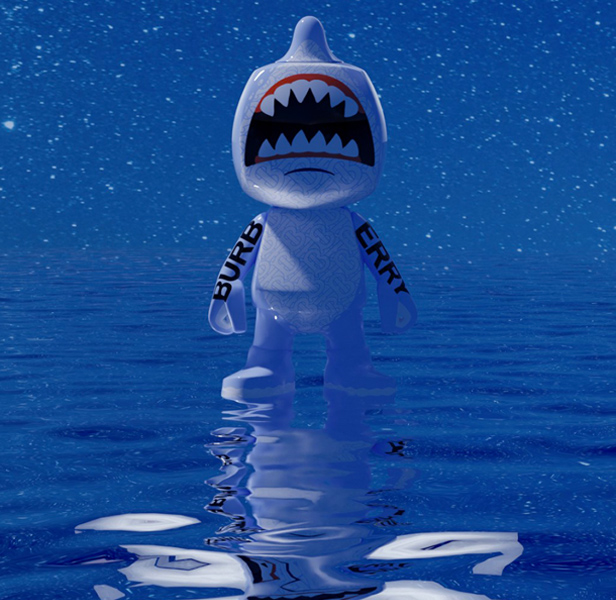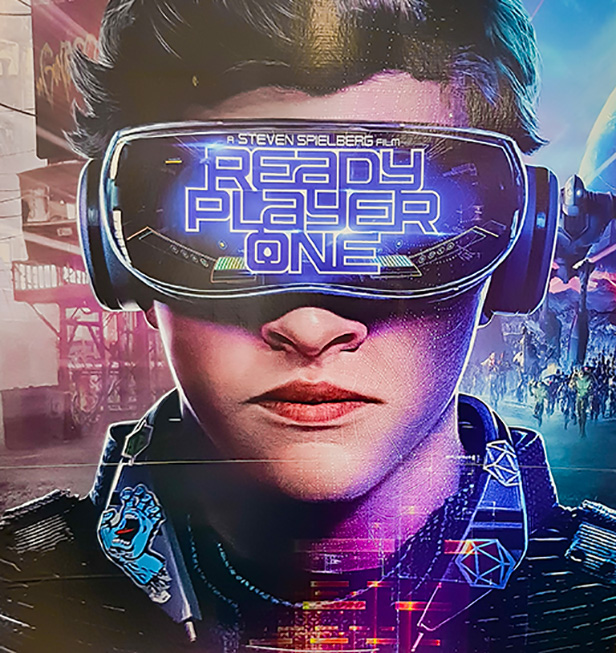Strategy January 27, 2022
Is the Future of Merch in the Metaverse?
Virtual worlds and goods are part of an economy worth billions. Now, a handful of promo professionals are exploring how to turn real-life branded products into lucrative digital assets.

Mark 2021 as the year the metaverse went mainstream.
In December, a fan spent $450,000 to be Snoop Dogg’s neighbor – not in real life, but in the digital world of “Snoopverse”. In the same month, Adidas sold more than $22 million in nonfungible tokens (NFTs) in the span of an afternoon. Elon Musk announced in a tweet that shoppers could buy some Tesla merch with Dogecoin, the cryptocurrency conceived as a joke and based on a meme.
And of course, Facebook (which began pushing the idea of virtual reality conference rooms), renamed itself Meta, which turned metaverse into a worldwide buzzword. (What exactly is the metaverse? Check out our glossary with definitions of all the latest digital terms.)
But is it all a passing fad or truly a trend with staying power? And what does this proliferation of digital assets and virtual worlds mean for the promotional products industry, which for so long has relied on tangible goods?
“I think that if we consider ourselves any sort of marketing people and any part of the marketing profession, we need to understand all the different elements of marketing,” says Gerry Barker, president of Cheshire, CT-based distributor Barker Specialty (asi/132690). NFTs, he adds, aren’t going away, and are increasingly going to be a part of marketing efforts. “If we can’t even talk or think about it, we’re sort of out of the conversation. Then, we’re just a commodity provider, not a real part of the marketing mix.”
Barker is one of a handful of promo industry professionals who have made early forays into digital merch, NFTs and the metaverse. Last summer, he turned one of the vintage gadgets from his family’s toy museum into an NFT – essentially a bit of information, like a digital trading card or artwork that’s unique and stored on the blockchain so that proof of ownership is verifiable and can’t be altered. Barker also partnered with Lisa Fosdick, vice president of sales at Tribe Socks (asi/92049), to create NFTs4Charity, which helps nonprofits and other fundraisers use the emerging technology.
New York City-headquartered Harper+Scott (asi/220052) just launched a new division, H+S META, focused specifically on delivering digital assets and experiences. “As the metaverse and its influence expands, we’re uniquely positioned to serve as a true partner to our clients in building their virtual worlds, from merchandise to experiences and the community that’s cultivated between,” says Michael Scott Cohen, Harper+Scott CEO/co-founder.
As people spend more of their time and money (billions of dollars’ worth) in these digital worlds, there’s certainly a case for promotional products to be as much a part of those worlds as our real one. And though it’s still early days, there’s a lot of marketing potential for brands and the promo companies that support them, according to proponents of this virtual frontier.
Digital ‘Skins’ & Virtual Fashion
Gen Z gamers – perhaps to the bafflement of their parents holding the purse strings – find value in purely digital goods. Many are more than willing to shell out real dollars to purchase outfits that exist only online – to ensure their avatars on games like Roblox and Fortnite fit their personal aesthetic or mood on any given day. “Fashion in the digital environment is pure fashion,” says Nathan Phillips, co-founder and director of concept design at advertising agency Technology, Humans And Taste. “There’s more freedom to express yourself and the way you dress as a digital avatar.”
Luxury designers have been quick to pick up on the significance of this trend. Balenciaga, for example, collaborated with Fortnite to offer special in-game “skins” as well as equivalent “real” clothing offline. Over the summer, Gucci created a Gucci Garden space on Roblox for two weeks, offering limited-edition and collectible digital accessories that the gaming platform’s some 50 million daily users could buy for up to $9.
Though it may seem, at first blush, surprising that the gaming community would be so responsive to high fashion, Giacomo Vigliar believes it makes sense. “Influencer marketing and social media have already proven that online identities are extremely important for consumers of all different backgrounds,” says Vigliar, an executive producer at UNIT9, a global production studio that has foothold in the digital and virtual worlds, among other specialties.
He adds that the metaverse is a natural extension of online identity creation: “The cultural relevance and overall cool factor that these intangible assets hold are clearly paramount.”
Plus, high fashion is already divorced from “real” value, so the idea of spending money on clothing that doesn’t physically exist isn’t such a leap. “If one is willing to pay $600 for a plain white T-shirt,” he says, “who’s to say they’re not willing to spend just as much on a virtual one that maybe even more of their friends will see?”

Forever 21 teamed up with Virtual Brand Group to create a shopping game on popular gaming platform Roblox. (Photo courtesy of Virtual Brand Group)
Fast fashion brands too are entering the metaverse. Forever 21 recently launched a game on Roblox called Forever 21 Shop City, where players can create and run a virtual version of the chain store. The Shop City game offers branding and marketing opportunities both in the virtual and physical worlds. Each month, Forever 21 drops around 2,000 different items in stores, which Shop City can replicate and even expand upon due to the lightning speed with which a digital asset can be created, says Justin Hochberg, CEO of Virtual Brand Group, the company that collaborated with Forever 21 to create the game. That means Forever 21 could potentially preview clothing collections online to test the waters before offering them in store.
Hochberg is also exploring a concept he calls “infinite loop marketing.” Rather than a traditional customer journey that has a distinct start and end point, the Shop City game could allow a scenario where a player buys, say, a cozy scarf, quilted purse and pom-pom earmuffs on Roblox, which then unlocks a secret code that can be used to get a discount at a physical Forever 21. Making a purchase at a physical store would then unlock a Roblox code, that offers in-game digital items. Getting the new digital items would unlock another store promotion, and so on. “We’re gamifying fashion,” Hochberg says. “It’s a never-ending loop of connecting the two worlds.”

Burberry created a collection of NFTs in partnership with a gaming company last summer. (Photo courtesy of Burberry)
Fashion brands are also jumping on the NFT bandwagon. Dolce & Gabbana made millions of dollars last year on several NFTs it minted, including two pieces of digital-only wearable art: the Mosaic Impossible Jacket and the Impossible Tiara. Burberry partnered with Mythical Games to launch a collection of NFTs – featuring video game characters adorned with the iconic Burberry monogram.
The Evolution of Virtual Events
When the pandemic forced many of us to shop, work and socialize online, virtual events and experiences took on a greater significance. In many ways, it was accelerating trends that were already on the verge anyway. 2020 was the year Zoom (and Zoom fatigue) entered the vernacular, as videoconferencing and livestreaming became a welcome connection with others – while almost simultaneously turning into a wearying burden.
Many brands and celebrities have moved beyond livestreaming, however, holding events in the metaverse, whether that’s in already established game universes or in burgeoning metaverse spaces. Ariana Grande and Travis Scott held concerts in Fortnite, Lil Nas X and Twenty One Pilots took to Roblox and Ed Sheeran partnered with Pokémon Go for an in-game performance. Meta also hosted three large – if largely unnoticed – virtual reality concerts in its Horizon Ventures metaverse to ring in 2022.
“Existing platforms like Roblox, Minecraft and Fortnite have incredible reach and accessibility – and brands can tap into those audiences quite easily,” Vigliar notes.
Fosdick believes VR events in the metaverse have massive potential for the promo industry. During a recent VerchX webinar on the future of promo, Fosdick recounted a virtual charity golf event she participated in that was put together by a company called Ready Player Golf. Fosdick was part of a foursome that included players from Scotland and Sweden. The event included a virtual helicopter ride through the metaverse, “drinks” in the clubhouse and an awards banquet at the end. “It immediately made me think of our industry,” Fosdick said during the webinar. “I could have had a branded hat on. There could have been a branded flag on the pin.”
Ready Player Golf 2, coming 9/24. Benefitting @XRSIdotorg. Featuring @vreducation & @proputtvr ⛳️ https://t.co/ox6Bq4thK6 pic.twitter.com/gQqLmpT0bA
— Ready Player Golf (@ReadyPlayerGolf) July 14, 2021
VerchX is a consulting agency put together by a handful of promo futurists, including Fosdick and Meg Erber, a sales leader at Top 40 supplier S&S Activewear (asi/84358). “I preach about adapting and evolving, and that’s what we’re doing now,” Erber says. “If the pandemic has taught us anything, it’s that we have the opportunity for a fresh restart for the promotional products industry.”
Marrying the Digital & Physical
Though brands are finding value in purely digital assets like NFTs and in-game fashion, the true sweet spot for the promotional products industry may be through the intersection of physical and digital goods.
For example, a company could mail out a pair of branded socks or other item in advance of a virtual event or trade show. Then a QR code on the packaging could direct the recipient to a place where they could purchase or redeem an NFT of the digital version of the socks, which could then be worn at the virtual event. “What jazzes me so much about this is our industry wastes so much on merch that’s thrown away,” Fosdick says. “This technology takes that away. We can be sustainable and effective and merge our physical merchandise we sell with the digital.”
“If we can’t even talk or think about NFTs, we’re sort of out of the conversation. Then, we’re just a commodity provider, not a real part of the marketing mix.” Gerry Barker, Barker Specialty
The transaction could also happen in the opposite way, where a person purchases an NFT, which then “unlocks” real-world merchandise and experiences. NFTs, which are purchased using cryptocurrency, become an immutable part of the blockchain, a sort of digital ledger. “It’s like a receipt,” says Marcus Blasche, head of marketing for The Sandbox, an NFT gaming metaverse, and founder of Rumble Kong League, a virtual basketball game featuring NFT avatars. “It unlocks whatever you want it to unlock.”
Last year, Kings of Leon became the first band to release an album as an NFT, and part of the release included an auction of six “Golden Tickets,” each of which guarantee the owner four front-row seats at every Kings of Leon headline tour for life. The 30,000 NFTs Adidas minted last year will be tied to actual physical merch that’s available for token owners to redeem for no extra cost sometime this year, according to Adidas.
WEN? EARLY ACCESS MINTING STARTS NOW
— adidas Originals (@adidasoriginals) December 17, 2021
👉 https://t.co/8l8dPwbZWG
First look of the collaborative NFT with @gmoneyNFT @punkscomic and @BoredApeYC
Good luck and #TracksuitUp pic.twitter.com/REYOSdRbNT
NFTs4Charity, Barker and Fosdick’s crypto venture, is also experimenting with unlockable content. The company arranged an NFT auction with the Elizabeth Glaser Pediatric AIDS Foundation, a charity founded by the late wife of Starsky & Hutch actor Paul Michael Glaser. Glaser offered two pieces of art he created to be animated and minted into NFTs by digital artist Trish Classe Gianakis. In addition to the NFT art itself, winners of the auction would receive a physical print of the digital painting, personalized and autographed by Glaser; a private phone or Zoom conversation with Glaser; a personalized and autographed copy of a book written by Glaser; a bundle of commemorative apparel; and a vintage, circa 1970s personalized and autographed photo of Glaser as Det. Starsky.
Though it seems inevitable that virtual reality and the metaverse will play an increasingly significant role in people’s lives, not everyone is on board with the concept of NFTs, at least as they’re being used now. “I think NFTs run the danger of becoming collectible coins, where you see late-night ads and they’re just hawking stuff for the sake of collecting them,” Phillips says. Critics also point out NFTs’ high environmental cost – in terms of energy used to create Ethereum, the cryptocurrency used to create them. Plus, the cryptocurrency and NFT world is rife with scams.
Still, it would be a mistake to ignore these developments in the digital world. “The metaverse is the biggest transformative change in brand touchpoints to consumers that’s ever happened,” Hochberg says. And, he adds, if you’re just dipping your toe in now, “you’re already late.”

Defining the Metaverse
Here’s a quick cheat sheet with some of the tech terms currently being bandied about, along with what they mean:
Metaverse: The term was coined in Neal Stephenson’s 1992 sci-fi novel Snow Crash, but the concept is often compared to the book and film Ready Player One, which depicts a 3-D virtual reality world where people work, play and socialize. People also refer to video games like Roblox and Fortnite as metaverses, since the virtual worlds exist even when you’re not playing in them with your digital avatar. The metaverse concept also encompasses aspects of augmented reality – think social media filters or games like Pokémon Go.
Blockchain: A blockchain is a distributed database shared among computer networks, allowing for secure and decentralized records of transactions.
Cryptocurrency: This is a form of digital currency created using blockchain technology, not backed or issued by a government or centralized authority. There are thousands of cryptocurrencies in existence, but among the more well-known are Bitcoin and Ethereum.
Digital asset: This is any image, video file or other piece of data stored digitally. It could be a virtual outfit or an item in a video game.
NFT: A nonfungible token is a way to show ownership of digital assets by minting them on the blockchain. NFTs can’t be broken up into smaller parts or replicated, but can be transferred and traded. They’re purchased using a cryptocurrency like Ethereum.
Smart contracts: Smart contracts are programs stored on the blockchain that run when certain conditions are met. Proponents of NFTs and cryptocurrency, like Gerry Barker of Barker Specialties, believe they’re the future of transactions. “I think we’ll all have crypto wallets,” Barker says. “Our wills, our X-rays, our passports, our diplomas will be minted as NFTs.”
Web3: A lot of futurists have been touting the idea of Web3, by which they mean a decentralized internet where “users can transport their data from service to service without corporate walled gardens stopping them,” explains tech writer Daniel Howley in a piece on Yahoo.
